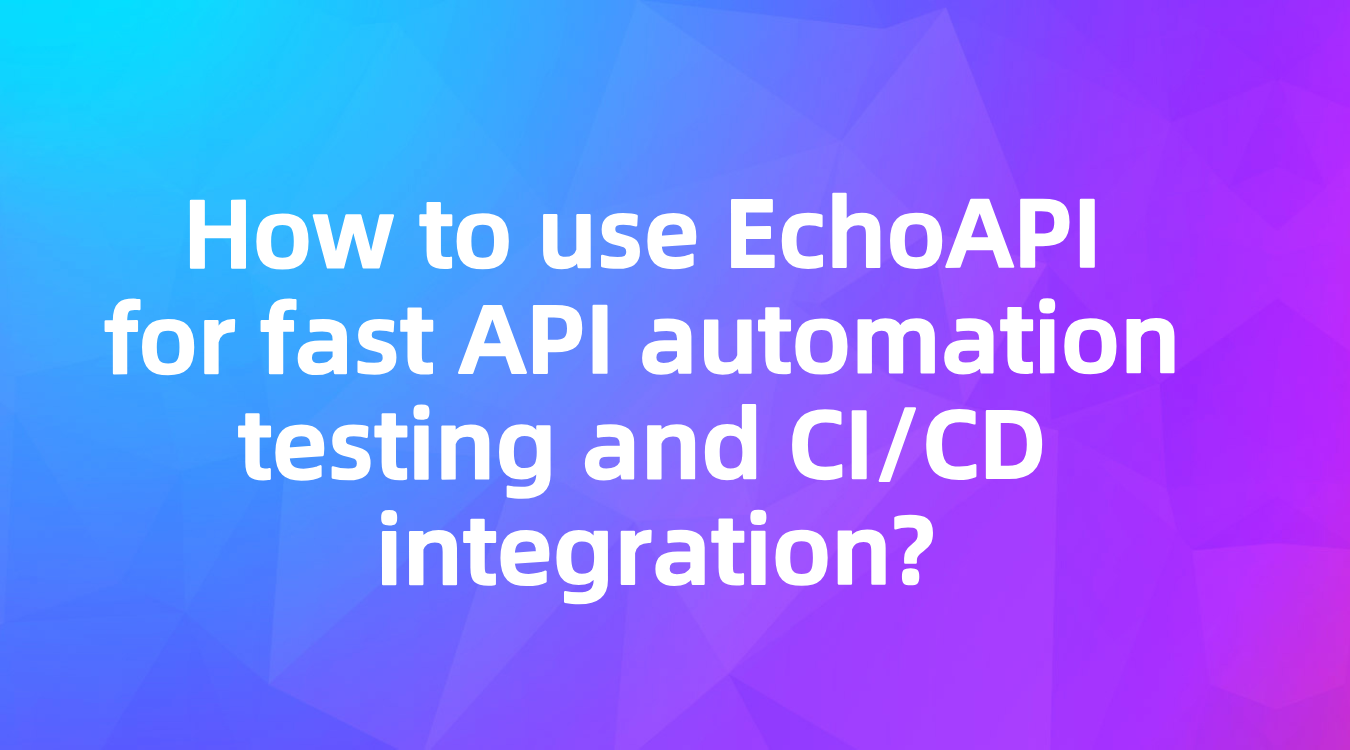From CURL to API Docs: How EchoAPI Revolutionizes API Development for Modern Engineering Teams
In this article, we'll explore how EchoAPI tackles the "phantom interface" problem, enhances collaboration, and integrates seamlessly into your existing workflow.
In today's fast-paced tech landscape, API development is both a cornerstone and a common pain point for engineering teams. From misaligned documentation to fragmented configurations, traditional workflows often lead to costly delays and frustrating inefficiencies. But what if there was a way to streamline these processes, making API development not just manageable but enjoyable? Enter EchoAPI—a game-changing solution designed to revolutionize how modern teams build, test, and deploy APIs.
In this article, we'll explore how EchoAPI tackles the "phantom interface" problem, enhances collaboration, and integrates seamlessly into your existing workflow.
The Phantom Interface Problem in Enterprise Development
"It works on my machine!"
"The docs say 'client_id' but the endpoint expects 'clientID'!"
"Frontend says the response is malformed, backend swears the request is wrong..."
Sound familiar? Let's talk about a real-world scenario from a fintech project: After deploying a critical update to their transaction service, a European bank's mobile team discovered the /transfer endpoint was rejecting valid requests. Developers spent hours comparing Postman collections, Swagger docs, and Confluence pages, only to find a discrepancy in date formatting (DD/MM/YYYY vs YYYY-MM-DD) between frontend and backend implementations.
This exposes three fundamental flaws in traditional API workflows:
- Configuration Fragmentation: Every developer's Postman/Swagger/Insomnia setup becomes a unique snowflake
- Documentation Debt: API specs drift from reality within hours of deployment
- Collaboration Overhead: Average 2.8 Slack threads needed per endpoint change
Reengineering the API Lifecycle with EchoAPI
1. CURL's Second Act
Modern development often starts with browser devtools:
# A typical CURL from Chrome Network tab
curl 'https://api.bank.com/v3/transactions' \
-H 'Authorization: Bearer eyJhb...' \
-H 'Content-Type: application/json' \
--data-raw '{"amount": 5000, "currency": "EUR", "recipient": "DE8937..."}'
Both Postman and Apipost support one-click import and direct debugging.
With EchoAPI:
Click "Import CURL", get instant executable API template with:
- Auto-recognized auth headers
- Structured request body validation
- Environment-aware variables (dev/staging/prod)
2. Documentation as Code
Let's examine a payment gateway API evolution:
| Version | Change | Traditional Docs Cost | EchoAPI Approach |
|---|---|---|---|
| v1 | Basic SEPA | 3 engineer-hours | Auto-generated from CURL |
| v2 | Add SCA | 5 engineer-hours | Update endpoint → Docs sync |
| v3 | PSD2 Compliance | 12+ engineer-hours | Version compare + audit trail |
Real Results: A Nordic open banking platform reduced documentation overhead by 78% while achieving PCI DSS compliance through EchoAPI's auto-generated audit trails.
3. Collaborative Workflows for Distributed Teams
Quantifying efficiency gains:
New Engineer Onboarding
- Legacy: 2 days (Clone repos, setup Postman, reconcile docs)
- EchoAPI: 15 minutes (Shared workspace import)
Breaking Change Management
- Legacy: Slack storm → Jira ticket → Docs update (4h avg.)
- EchoAPI: Change notification + auto-generated migration guide (Real-time)
Production Incident Triage
- Legacy: Screenshot ping-pong (1.5h avg. MTTR)
- EchoAPI: Share reproducible test case with env variables (3 clicks)
Building Enterprise-Grade API Ecosystems
1. Smart Workspaces in Action
# Traditional test scripting
def test_transaction_rollback():
# Manually maintained test data
test_cases = [
{'amount': 10000, 'currency': 'USD'}, # Threshold for AML check
{'amount': 9999, 'currency': 'USD'}
]
for case in test_cases:
# Environment-specific configurations
response = post(f"{os.getenv('STAGING_API')}/transactions", data=case)
assert response.status_code == 202 if case['amount'] < 10000 else 403
# With EchoAPI Test Suites
# 1. Store AML threshold as environment variable
# 2. Create data-driven test with conditional assertions
# 3. Run across dev/staging/prod with one click
2. API-as-Product Strategy
How a SaaS company transformed their developer portal:
Legacy Flow:
Develop → Write Docs → Push to ReadMe → Customers See Changes
↑ │ ↓
└─ 48h Delay ─┘
EchoAPI Flow:
Develop → EchoAPI Docs Auto-Update → GitHub Pages Sync
↑ │
└─ Instant ──────┘
Outcome: 63% reduction in support tickets about API discrepancies, with developer portal engagement up 212%.
Beyond Tooling: Strategic Value Creation
In CI/CD pipelines, EchoAPI enables:
- Living API Catalog
- Versioned endpoints with usage analytics
- Automated changelog generation per Git tag

- Shift-Left Quality
- Contract testing via OpenAPI specs during PR reviews
- Load test scenarios defined in development
- Compliance-as-Code
- GDPR/CCPA data pattern detection in request/response
- Audit-ready documentation with SOC2 controls mapping
The CTO's Playbook: Metrics That Matter
Data from 20+ enterprise adopters shows:
| Metric | Improvement | Business Impact |
|---|---|---|
| Integration Cycle Time | -61% | Faster partner onboarding (e.g., Adyen) |
| Production API Incidents | -54% | Reduced P1 outages in payment processing |
| DevRel Efficiency | +89% | 83% of API docs traffic from 3rd-party devs |
Implementation roadmap for global teams:
1.Tactical Adoption
Start with pain points:
- API debugging in microservices
- Partner-facing documentation
- Process Integration
2.Embed EchoAPI in existing workflows:
- Jira for change management
- Datadog for monitoring
- GitHub Actions for CI/CD
3.API-First
- Measure API quality metrics (error rate, latency, docs coverage)
- Implement API governance policies
As the lead architect at a Fortune 500 insurance company put it: "EchoAPI didn't just change our tools – it changed how we think about APIs as business products." In today's API-driven economy, choosing the right foundation isn't just about developer experience – it's about building competitive advantage.
Ready to Transform Your API Workflow?




 EchoAPI for VS Code
EchoAPI for VS Code

 EchoAPI for IntelliJ IDEA
EchoAPI for IntelliJ IDEA

 EchoAPl-Interceptor
EchoAPl-Interceptor

 EchoAPl CLI
EchoAPl CLI
 EchoAPI Client
EchoAPI Client API Design
API Design
 API Debug
API Debug
 API Documentation
API Documentation
 Mock Server
Mock Server








